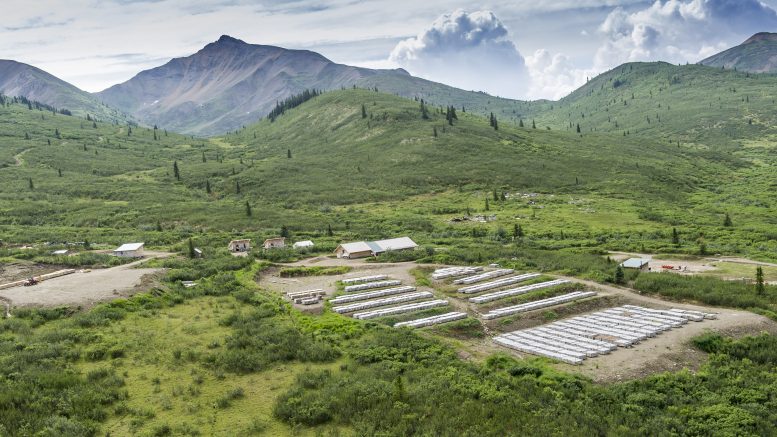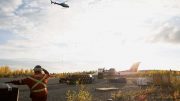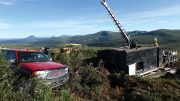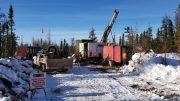Atac Resources (TSXV: ATC; US-OTC: ATADF) has outlined this year’s exploration program for its 1,700 sq. km Rackla gold property in east-central Yukon, and according to the company, it’s the biggest since 2012. The program will begin in May.
Rackla is composed of three projects and plenty of exploration upside. The wholly owned, 12 sq. km Carlin-style Osiris gold project hosts the Conrad, Osiris, Sunrise and Ibis gold zones. The Rau project, also 100% owned, most notably hosts the Tiger gold deposit. And the Orion gold project is under option to Barrick.
“This is going to be about expanding our resources or expanding on all of our zones,” Atac president and CEO Graham Downs says in an interview with The Northern Miner. “All of the zones we’re working on remain open, so that’s a pretty big positive.”
The exploration program will have a $13-million budget for 20,000 metres of drilling. Atac will contribute $7 million to fund exploration at Osiris and Rau, while Barrick will contribute $6 million on Orion.

At Atac Resources’ Rackla gold project in the Yukon. Credit: Atac Resources.
“We brought Barrick in because the land package is so large,” Downs says. “There’s a lot of potential and it’s just hard to fund the entire project.”
Barrick will drop 10,000 metres into Orion this year, mainly on the Anubis fault corridor. Before the option agreement, Atac drilled 3,000 metres along Anubis. Under a 2017 agreement, Barrick can earn up to a 70% interest on the 780 sq. km Orion project if it spends $63.3 million, inclusive of $8.3 million spent in 2017 via a flow-through private placement, which leaves aggregate exploration expenses of $55 million.
“They did a lot of stratigraphic drilling last year,” Atac vice-president of corporate affairs Matthew Keevil says. “The big thing for Barrick this year is that they’re going after gold. They’re target drilling this year and looking for gold mineralization.”
He adds that Atac had upwards of seven Barrick geologists at Rackla last year and that “they’re the specialists in Carlin-style mineralization,” and Atac is “learning a lot from them.”

At work on Atac Resources’ Rackla gold property in the Yukon. Credit: Atac Resources.
According to Downs, Atac will expand mineralization at the Osiris project’s Sunrise and Conrad zones. Last year, the company found 13.52 grams gold over 15.2 metres at Sunrise and 20.78 grams gold over 12.5 metres from 55 metres downhole at the eastern end of the Conrad zone.
“We were aiming for gold mineralization below,” Downs says of the mineralization at Conrad. “But we found that. It was a pleasant surprise.”
He adds that almost all of the drilling in 2018 will be expansion drilling, with the potential for Atac to calculate a maiden resource on Osiris. However, even if Atac releases a resource estimate, it may not include all of this year’s drilling. He adds that if the gold price “continues to cooperate” and there’s an opportunity to ramp up exploration, Atac may add 5,000 to 10,000 metres later in the season.
The company has received an agreement between the Yukon government and the First Nation of Na-Cho Nyak Dun stating that the 65 km private, all-season tote road to Atac’s Tiger gold deposit may proceed. Atac defined a carbonate replacement-style gold deposit at Tiger between 2006 and 2010, drilling nearly 27,000 metres across 150 holes.
The project contains 5.68 million measured and indicated tonnes grading 2.66 grams gold per tonne and 3.56 grams silver for 485,700 oz. gold and 649,900 oz. silver. It has another 3.23 million inferred tonnes grading 1.81 grams gold and 0.92 gram silver for 188,500 oz. gold and 95,600 oz. silver.
Atac tabled an updated preliminary economic assessment for Tiger in 2016. According to the study, the project has a $75.7-million, after-tax net present value and a projected 28.2% after-tax internal rate of return. The study estimates $109 million in pre-production capital expenses, with life-of-mine sustaining capital costs totalling $8.3 million and an all-in sustaining cost of US$864 per oz. gold. The 2016 study extends Tiger’s mine life by two years to 6.2 years, compared to the 2014 version.

Atac Resources’ Rau’s Tiger deposit on the Rackla property in the Yukon. Credit: Atac Resources.
Downs calls the road agreement one of the “very few that have been done with the government of the First Nation and the Yukon government” and a “very good collaborative effort.” Still, Atac will have to work with the other parties on a management plan, and Downs says he doesn’t expect construction on the road to finish until early 2020.
“We want to make sure that we do this right and the First Nation and the Yukon government wanted to do a little bit of extra work, and we support that,” Downs says. “Ideally we would like to have had it sooner, but we respect the decision document from both the governments.”
The Rau project also hosts several other targets of interest to Atac. The Condor target, located 1.5 km northwest of Tiger, returned grab samples grading 17 grams gold, 9.46 grams gold and 23.3% zinc during the company’s 2017 exploration program. The same program brought two new target areas: Spotlight and Northwest.
Grab samples at Northwest returned 1.43 grams gold and 4.14% zinc, while samples at Spotlight returned 7,080 grams silver and 4.63% copper. Keevil says Atac will have staff at Rau this year increasing the density of soil sampling to “set up another discover opportunity” on the next round of drilling.
Atac shares are trading at 62¢ apiece with a 52-week range of 46¢ to 89¢. The company has an $87-million market capitalization.
“The Yukon government is very supportive of mineral exploration and mining in the Yukon,” Downs says. “It’s getting harder and harder to work around the world without having countries or jurisdictions tax you and take back your deposits.”






Be the first to comment on "Atac, Barrick prepare to launch drill program at Rackla"